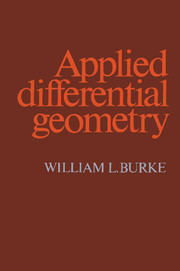Book contents
- Frontmatter
- Contents
- Preface
- Glossary of notation
- Introduction
- I Tensors in linear spaces
- II Manifolds
- III Transformations
- IV The calculus of differential forms
- V Applications of the exterior calculus
- VI Classical electrodynamics
- VII Dynamics of particles and fields
- VIII Calculus on fiber bundles
- IX Gravitation
- Bibliography
- Index
- Frontmatter
- Contents
- Preface
- Glossary of notation
- Introduction
- I Tensors in linear spaces
- II Manifolds
- III Transformations
- IV The calculus of differential forms
- V Applications of the exterior calculus
- VI Classical electrodynamics
- VII Dynamics of particles and fields
- VIII Calculus on fiber bundles
- IX Gravitation
- Bibliography
- Index
Summary
No one would try to teach electrodynamics without using vector calculus. It would be crazy to give up so powerful a tool, and it is hard for us to appreciate the resistance to vector calculus shown at the turn of the century. The mathematics of this book can be thought of as the proper generalization of vector calculus, div, grad, curl, and all that, to spaces of higher dimension. The generalization is not obvious. Ordinary vector calculus is misleading because the vector cross product has special properties in three dimensions. This happens because, for n = 3, n and ½ n(n - 1) are equal. It is also important to divorce the formalism from its reliance on a Euclidean metric, or any metric for that matter. Other structures are important, and we must make room for them. Also, a metric allows some accidental identifications that obscure the natural properties of the geometric structures. Similarly, the linear and affine structure of Cartesian spaces should be included only if it is appropriate. The mathematics satisfying these conditions is not classical tensor calculus, but what is called calculus on manifolds and, in particular, the calculus of differential forms.
What physical problems does this calculus address? The basic idea of any calculus is to represent the local behavior of physical objects. Suppose you have a smooth distribution of, say, electric charge. The local behavior is called charge density.
- Type
- Chapter
- Information
- Applied Differential Geometry , pp. 1 - 10Publisher: Cambridge University PressPrint publication year: 1985

